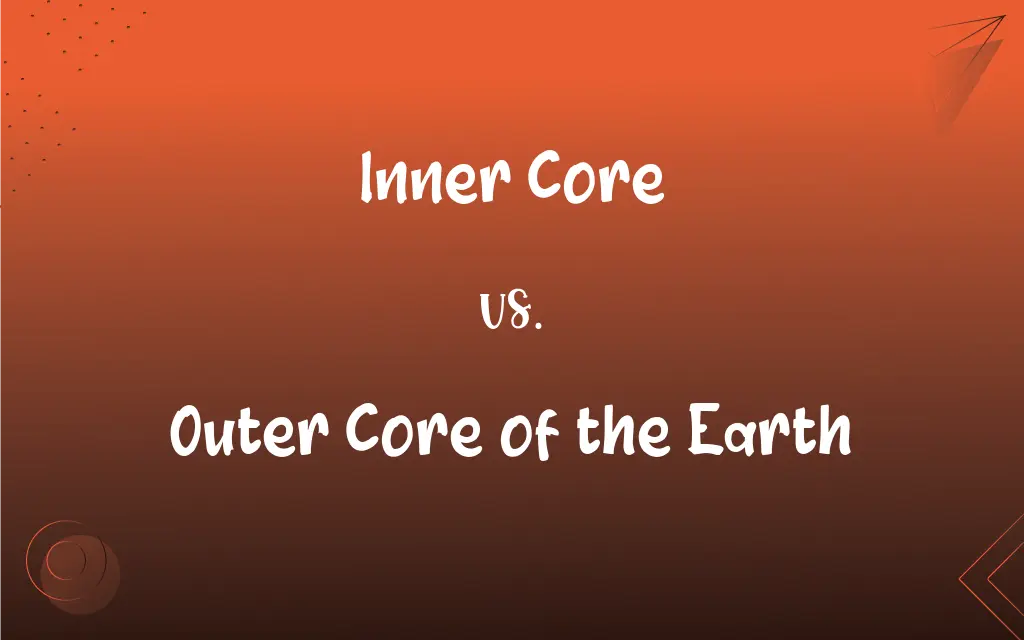Inner Core vs. Outer Core of the Earth: What's the Difference?
Edited by Aimie Carlson || By Harlon Moss || Updated on October 6, 2023
The inner core is a solid sphere of iron-nickel alloy, while the outer core is a molten layer of liquid iron and nickel encircling it.

Key Differences
The inner core and outer core of the Earth, while adjacent, differ substantially in their physical states and properties. The inner core is solid, primarily composed of iron and nickel under immense pressure, rendering it solid despite its extremely high temperatures. Contrarily, the outer core, although composed of similar materials — predominantly iron and some nickel — exists in a molten, liquid state due to the slightly lower pressures it experiences compared to the inner core.
Distinguishing the inner core and outer core of the Earth requires understanding of their respective roles in terrestrial phenomena. The solid inner core, with its intense heat, influences the overlying outer core, facilitating the generation of the Earth's magnetic field through the process of convection currents occurring in the molten outer core. This differential in states and the ensuing movements in the outer core are pivotal to the dynamo effect, which is instrumental in engendering our planet's magnetism.
Within the context of geology and seismology, both the inner core and outer core serve as focal points of study to comprehend the Earth’s interior and its associated processes. The inner core is often a subject of intrigue due to its ability to withstand melting despite its extreme temperatures, attributed to the immense pressures exerted upon it. The outer core, with its liquid state and motion, presents a compelling contrast, as its movements are crucial for understanding Earth’s geomagnetic properties and seismic activities.
Understanding the structure and characteristics of the Earth’s inner core and outer core is paramount in deciphering the Earth’s geological and geomagnetic narratives. The inner core, being solid, facilitates the propagation of seismic P-waves, while S-waves cannot traverse through the liquid outer core, providing crucial data for the study of seismology. These fundamental distinctions in physical state and seismic behavior between the inner and outer core enable researchers to gather data and formulate theories about Earth's interior.
Temperature gradients between the solid inner core and the liquid outer core are instrumental in driving the convective processes that occur within the Earth's interior. This dynamic interplay between the hotter inner core and the cooler, yet still extremely hot outer core, facilitates the movement of molten iron in the outer core, generating the geomagnetic field that envelops our planet. Thus, the disparate physical states of the inner and outer core contribute significantly to the sustenance of vital planetary features, such as the geomagnetic field.
ADVERTISEMENT
Comparison Chart
State of Matter
Solid
Liquid
Material Composition
Predominantly iron-nickel alloy
Predominantly liquid iron and nickel
Role in Magnetic Field
Generates heat, affecting the outer core's convective motion
Facilitates the generation of Earth's magnetic field via convection currents
Seismic Wave Propagation
Allows the passage of P-waves
S-waves cannot traverse, only P-waves do
Temperature and Pressure
Extremely high pressure and temperature
Slightly lower pressure and temperature compared to inner core
ADVERTISEMENT
Inner Core and Outer Core of the Earth Definitions
Inner Core
The inner core is the solid, central layer of the Earth.
The inner core's solid state influences the Earth's magnetic field generation.
Outer Core of the Earth
The outer core facilitates the creation of Earth's magnetic field through convection currents.
Movement within the outer core produces electric currents, contributing to Earth's magnetism.
Inner Core
The inner core facilitates the passage of seismic P-waves.
Studying the transmission of P-waves through the inner core provides insights into Earth's interior.
Outer Core of the Earth
The outer core is a liquid layer composed mainly of iron and nickel beneath Earth's mantle.
The outer core's molten iron generates our planet's magnetic field through convective motion.
Inner Core
The inner core, the Earth's innermost layer, influences the geomagnetic field.
Movements and temperatures in the inner core impact the convective currents in the outer core.
Outer Core of the Earth
Encompassing a fluidic state, the outer core surrounds the solid inner core.
The liquid state of the outer core plays a crucial role in the generation of Earth's geomagnetic field.
Inner Core
Comprising mainly iron and nickel, the inner core experiences extreme pressures and temperatures.
Despite the intense heat, the immense pressure keeps the inner core in a solid state.
Outer Core of the Earth
The outer core is discernible through its inability to transmit seismic S-waves.
The refraction of S-waves indicates the boundary between the mantle and the outer core.
Inner Core
The inner core exhibits rotational behavior distinct from the Earth's surface.
The inner core rotates at a slightly different rate compared to the rotation of the Earth's crust.
Outer Core of the Earth
Situated beneath the mantle, the outer core reaches temperatures between 4400 °C and 6100 °C.
Despite the immense heat, the outer core remains liquid due to the lower pressure compared to the inner core.
FAQs
How does the outer core contribute to Earth’s magnetic field?
The outer core generates the Earth’s magnetic field through convection currents of its molten iron and nickel.
How do scientists study the inner core?
Scientists study the inner core through the analysis of seismic waves generated by earthquakes.
What state of matter is the inner core?
The inner core is in a solid state.
Does the outer core contain elements other than iron and nickel?
Yes, the outer core also contains lighter elements like oxygen, sulfur, and silicon in smaller amounts.
How thick is the inner core?
The inner core is about 1,220 kilometers (758 miles) thick.
Does the inner core rotate?
Yes, the inner core rotates, and it is believed to rotate slightly faster than the Earth’s surface.
What role does the outer core play in plate tectonics?
The outer core's convection currents indirectly influence plate tectonics by affecting mantle convection.
Why is the outer core not solid like the inner core, despite being composed of similar materials?
The outer core is not solid due to the lower pressures it experiences compared to the inner core.
What materials constitute the inner core?
The inner core is primarily composed of an iron-nickel alloy.
How do scientists gather information about the outer core?
Scientists infer properties of the outer core through seismic wave studies and computational modeling.
Is the inner core growing?
Yes, the inner core is gradually growing as the Earth cools and more of the outer core solidifies onto it.
Is the outer core solid like the inner core?
No, the outer core is in a liquid state.
Why doesn't the inner core melt despite its high temperature?
The inner core remains solid due to the immense pressures exerted upon it.
What would happen if the outer core became solid?
If the outer core solidified, it would likely disrupt the generation of the Earth’s magnetic field.
How does the movement in the outer core affect the inner core?
Movement and heat from the outer core can affect the inner core by influencing its growth and affecting its temperature.
Which core layer, inner or outer, is involved in creating the Earth's magnetism?
The outer core is instrumental in creating Earth's magnetism through its convective currents.
Is the outer core capable of transmitting both P-waves and S-waves?
The outer core allows the passage of P-waves but not S-waves.
How hot is the inner core?
The inner core is estimated to be as hot as the surface of the sun, around 5700 K (5430 °C).
What is the boundary between the outer core and the mantle called?
The boundary between the outer core and mantle is known as the Gutenberg Discontinuity.
How does pressure in the inner core compare to the outer core?
The pressure in the inner core is substantially higher compared to the outer core.
About Author
Written by
Harlon MossHarlon is a seasoned quality moderator and accomplished content writer for Difference Wiki. An alumnus of the prestigious University of California, he earned his degree in Computer Science. Leveraging his academic background, Harlon brings a meticulous and informed perspective to his work, ensuring content accuracy and excellence.
Edited by
Aimie CarlsonAimie Carlson, holding a master's degree in English literature, is a fervent English language enthusiast. She lends her writing talents to Difference Wiki, a prominent website that specializes in comparisons, offering readers insightful analyses that both captivate and inform.
































































